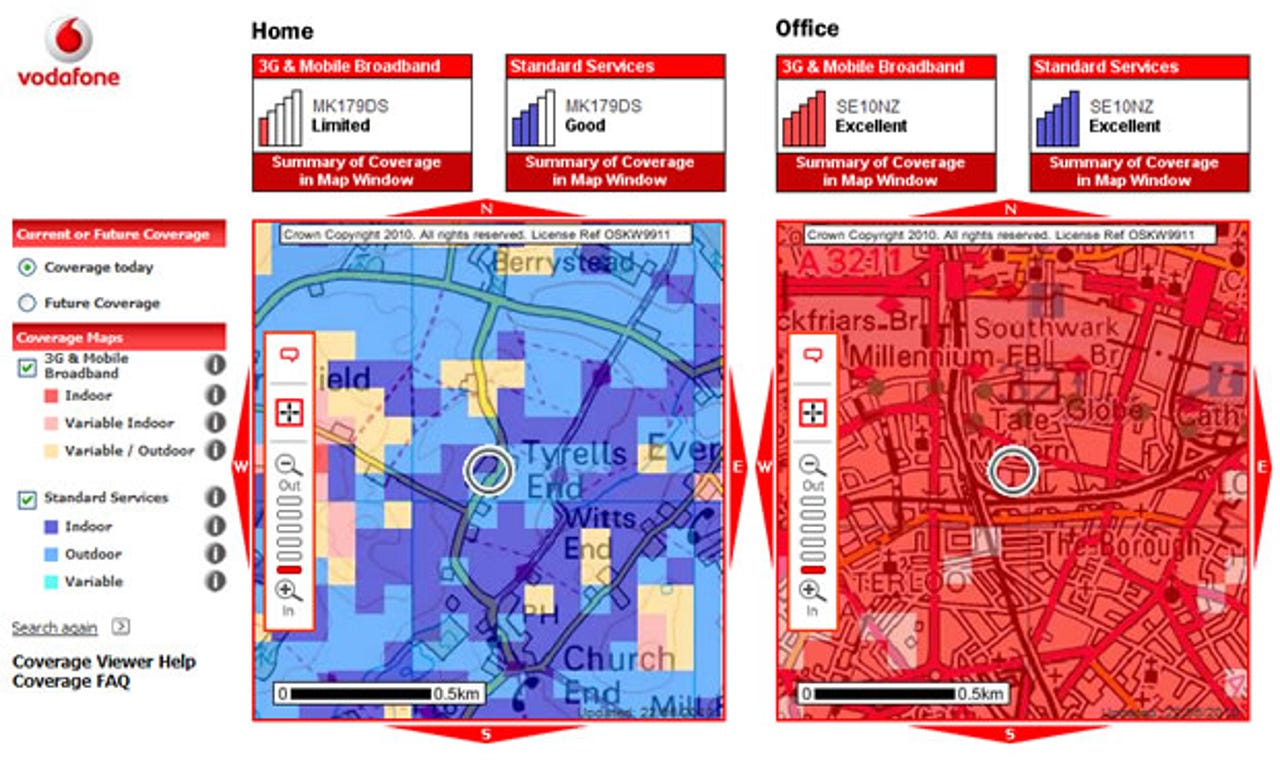Vodafone Sure Signal: inside a femtocell

Mobile Network Operators (MNOs) are in the business of enticing customers with an appealing combination of phones, tariffs, coverage and services, and then — crucially — retaining those customers by keeping pace with their rivals' offerings. Obviously no-one in their right mind is going to sign up with an MNO that delivers poor or non-existent coverage where they live or work. And yet, there are yawning gaps in all operators' 3G coverage maps — particularly in rural areas.
Take Vodafone and the home/work locations of one of this article's authors (CM) as an example. There's no problem at ZDNet UK's London offices, where both 'standard' and '3G & Mobile Broadband' services get five-bar coverage. But some 50 miles north-west, in rural Bedfordshire, the situation is very different, with particularly poor 3G service:

50 miles makes a big difference to Vodafone's network coverage when the endpoints are rural Bedfordshire (above left) and central London (above right)
The obvious answer, to build more mobile masts and provide 100 percent five-bar 3G coverage, isn't always economical or even technically feasible for MNOs — there will always be 'dead spots' even in generally well-covered locations. So last year Vodafone began offering a solution — femtocells. A femtocell is a small mobile base station, about the size of a domestic wireless router (see below), that delivers a house-plus-garden-range mobile signal and uses fixed broadband (typically ADSL) to route voice and data traffic.
Vodafone's Sure Signal femtocell costs a one-off £50 for contracts over £25 a month, or £120 for cheaper contracts
Originally launched in July 2009 as the Vodafone Access Gateway, this Sagem-made femtocell got a price cut (from £160 to £50 or £120 depending on contract) and a friendlier-sounding name, Sure Signal, in January this year.
To use Sure Signal, you need a fixed broadband connection with at least 1Mbps of throughput to handle the backhaul. You can register up to 32 Vodafone mobile phone numbers online, and use up to four handsets simultaneously for any combination of voice and data. Once the initial, roughly hour-long, setup is complete, you'll see your mobile signal boosted. You can go online and edit the roster of registered numbers at any time.
We've been using the Sure Signal in Bedfordshire for a few months now and can confirm that it works just fine. The Vodafone signal within the two-storey, three-bedroom house went from non-existent to five bars, and extended a reasonable distance into the garden. Signal was impaired only when (a) the village suffered a power cut or (b) the broadband connection went down.
So what exactly is inside the Sure Signal box, and how does the traffic it handles interface with Vodafone's network?
The Sagem-made Sure Signal exposed
The Sure Signal box contains a mobile phone base station in miniature, one that uses your broadband as the backhaul connection to Vodafone's switching centre. No surprise, then, to find a collection of radio and data components inside it. The centre of the design is the PicoChip PC202, which is a multicore ARM 9-based digital signal processor. This is programmable, but can handle GSM, HSPA, TD-SCDMA, cdma2000 and so on, plus the interfaces required to handle the memory, networking and control circuitry. It works in association with a Xilinx Spartan-3E FPGA, which handles encryption, Network Time Protocol (NTP) Ethernet packet timestamps and the interface between the PC202 and the radio chips. PicoChip has already introduced the PC302, which does away with the external FPGA and chops around £20 off the component cost: both designs can manage four handsets simultaneously, while the more meaty PC323 can handle more handsets and is more appropriate to enterprise, campus or metropolitan 'fill-in' work.
Conceptually, the electronics of a femtocell aren't that different to that of any other wireless gateway, but there are some practical differences. There's more power involved, because mobile handsets move around in a very complex radio landscape with lots of objects shielding transmissions. Here, the radio side is taken care of by a 2-watt power amplifier and two Maxim chips, one for transmission, one for reception, all conveniently situated towards the top of the box where they can feed the 3G antenna that's built into the circuit board.
The device also has to work to a much higher standard of frequency accuracy, as it works in a band shared with other operators who have paid a lot of money for assurances that they won't be subject to interference. Thus, the main frequency standard in the femtocell lives in a tiny oven with its own heat source and insulation. The frequency is generated from a quartz crystal whose physical dimensions set the speed of oscillations: as temperatures vary, the size of the crystal varies and thus the frequency. Mobile phone base stations use atomic standards, either by a local atomic clock or through the GPS satellite system, but the lower power of a femtocell allows a somewhat more relaxed approach.
There are things that the femtocell needs to do in conjunction with the network operator's systems. It needs to authenticate the handset, to make sure the account is valid, and it needs to tell the system where the handset is so that it can receive calls. This takes place over a secure VPN pipe established between the femtocell and Vodafone. However, while it's technically feasible that all data thereafter is routed directly from the Sure Signal to your local ISP, it in fact travels through the VPN and Vodafone's infrastructure first — and, indeed, counts towards any tariff charges or limitations that you may have.
This is a curious state of affairs. In the US, AT&T — which operates a similar system of counting femtocell data as if it went via the main system — claims that regulatory requirements to monitor all data force it to impose the same charges. However, it's not clear whether this is a valid interpretation of the regulations. We understand that it costs around £5 per gigabyte for a network to handle data over its own network of base stations: the cost via femtocells is two-thirds less — and yet it's charged identically. This highlights one of the most controversial aspects of these devices: that while they can be considered to fill in gaps in an operator's network and leave the cost of the backhaul to the customer, the operator normally charges both for the femtocell and for the traffic it passes. And with data caps becoming de rigueur, watching a YouTube video at home over your own network could result in significant extra cost if it pushes you over your monthly allowance.
The future of femtocells depends largely on such issues. The technology is well understood and well implemented, and there's a lot to be said for using it to increase mobile phone and data coverage. The more popular it becomes, the lower the cost of the hardware and the more attractive as a solution it will seem — to the point where it's conceivable that it could be a standard feature of wireless home routers. What's holding things back are regulation and the complexity of the network operators' own billing and other infrastructure systems.